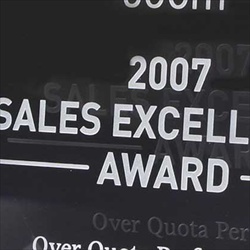Glass Engraving
There are many ways to conduct Glass Engraving. Some ways simply ‘mark’ the glass and others ‘deep engrave’. To find a really good Glass Engraver, please look at The Glass Engravers Websites list. The best form of Engraved Glass is subject to requirements. If there is any form of ‘Art’ required (e.g. an animal, bird – or calligraphy), then undoubtedly the talents of a Hand Engraver is required. And you can find out more on our Crystal Engraving page. For ‘Commercial Glass Engraving’, please read on to find out about the different methods used for Glass Engraving and what you might expect to end up with on your Engraved Glass.
Sandblast Glass EngravingYou will do well to ask your potential supplier of Engraved Glass what form of machinery and method they use for Glass Engraving. Sandblast Glass Engraving is, without doubt, the best, because it provides faithfully engraved crisp lines, combined with deep engraving. To learn more about Sandblast Engraved Glass, please take a moment to learn by visiting our ‘How We Do What We Do’ page. The image on the right shows the effect of deep Glass Engraving by the sandblast method. Note how the engraving is smooth and even, as well as being crisp and deep. Laser Engraved GlassA surface engraved glass, using a laser, leaves a line of ‘impacts’, where the laser has fired many thousands of times onto the surface of the glass. In comparison to Sandblast Glass Engraving, the finish is quite ‘scratchy’ and has no depth to it. Having said which, the pattern is as faithful as the artwork preparation and the set up of the software driving the laser. |
Detail of well engraved glass, using the sandblasting method. |
Another form of Laser Glass Engraving is ‘sub-surface’. This is either 2D or 3D. 2D sub-surface Laser Glass Engraving is used for ‘flat’ images, photographs, text and so forth. 3D sub-surface Laser Glass Engraving is, as its name implies, used for three-dimensional engraving, a building, a human form and so forth. The impact of the laser creates a ‘fissure’ within the glass and it is not unusual to utilise half a million fissures to build up an image within the glass. There is a great deal of fascination provided when viewing sub-surface laser engraved glass. It can be seen, but cannot be touched!
Machine Engraved Glass
The machines referred to are usually designed for engraving metals, plastics and so forth. They utilise a diamond cutter, which is dragged across the surface of the material and cut into it, by use of pressure. If you can imagine dragging a diamond across the surface of glass, you can also imagine the scratching, scraping sound – which mirrors the sort of finish one can expect for the Engraved Glass. To build up a line thickness of, say, 3mm, the diamond would need to pass several times, creating ridges in the glass. Often, crests and logos with large areas to engrave can look quite messy, when compared to Sandblast Glass Engraving.


